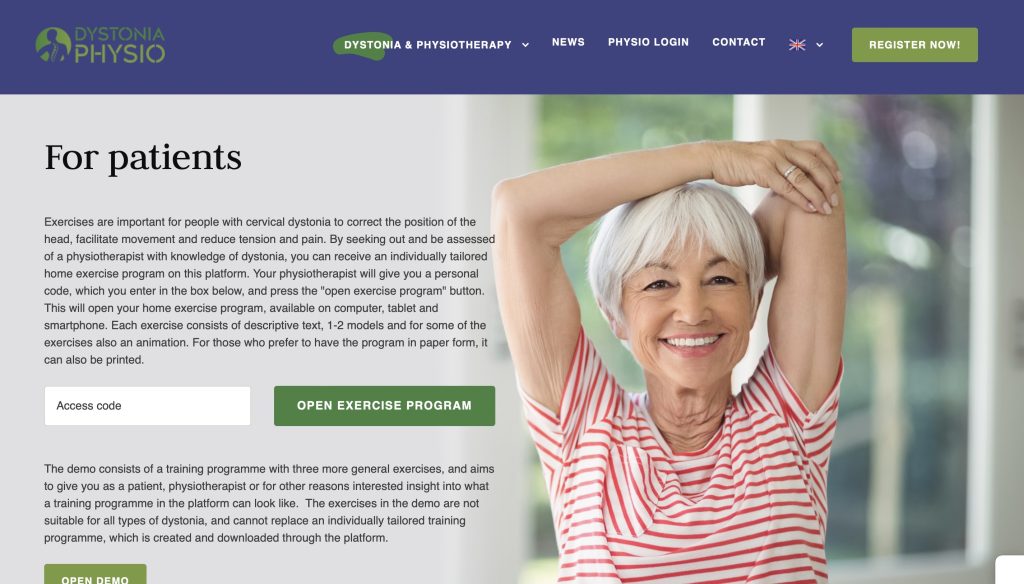
One year ago, a digital platform for cervical dystonia was launched in Sweden, and a few weeks ago, on 28 November it was time for the launch in Europe. Research has shown that Botulinum toxin injections (BoNT-inj) combined with physiotherapy provide good benefit for most people with cervical dystonia (CD).
Advanced treatment with Deep Brain Stimulation (DBS) also requires physiotherapy. Repetition of exercises is important to influence brain remodelling and achieve long-term improvements.
Exercises should be individualised according to the pattern, nature and problem areas of dystonia. CD can manifest itself in a wide variety of individual patterns, switch in intensity depending on position, and respond negatively or positively to arm movements.
Therefore, the physiotherapist needs to have access to a large number of exercises, with the ability to make an appropriate selection for the patient in question, and create a personalised exercise programme. With this as a basis together with the pandemic’s increased focus on digital solutions, I, Johanna Blom, physiotherapist in Sweden, came up with the idea of a digital platform.
The platform is being developed in close collaboration with Dystonia Europe (DE) and its IT expert Eelco Uytterhoeven and Executive Director Monika Benson. For the European launch a group of physiotherapy specialists from England, France, Germany, the Netherlands and Spain have joined our team.
The Boston Scientific Foundation Europe (BSFE) has endorsed our application for funding for this project, enabling us to move from idea to reality.
The platform is not a commercial business and will be free of charge for both users and healthcare.
For access to all the 115 exercises and possibilities to create training programs for patients with CD, the physiotherapist has to register on the public page and get approval.
Right now, there are about 80 Swedish physiotherapists registered on the platform. After an assessment of the patient, the physiotherapist can use the filter functions in the platform and create the training program for the patient. The program will be visible to each patient digitally on the public page through a personal code. For those who are not comfortable with the digital version, there is also the option to print the programme.
The public page is for everyone interested in CD, and there is information directed to the patients or physiotherapists, principles of physiotherapy, links to the dystonia associations in different European countries, a news section, information about the platform and a demo etc.
With the European launch there are some great and important updates. First of all, the platform is now available in a total of 6 languages including Swedish. New languages are: English, French, Spanish, German and Dutch.
The exercises are provided with 3D models, and with the recent update about half of the exercises are animated. The platform has a brand new design of both the public and the professional page, and better functions are in use.
The public page, where the patient can access his/her program, works on computers, tablets and smartphones, while computers are recommended for working on the physiotherapy page. It should be emphasised that the platform does not replace a physiotherapy contact, but relies on the presence of a physiotherapist who makes an analysis of the dystonia, and chooses the appropriate exercises. However, the platform makes it easier for the physiotherapists to find and select exercises, to communicate them and for the patients to take responsibility for training and to influence their situation.
Together with DE, I sincerely hope that this platform, the Dystonia Physio Exercise Hub, will be of great benefit for the patients, all over Europe, suffering from cervical dystonia!
With hopeful greetings
Johanna Blom. leg physiotherapist
Neurology department, University Hospital of Skåne, Malmö, Sweden
You can find the platform here:
https://physioexercise.org/en?locale=en

